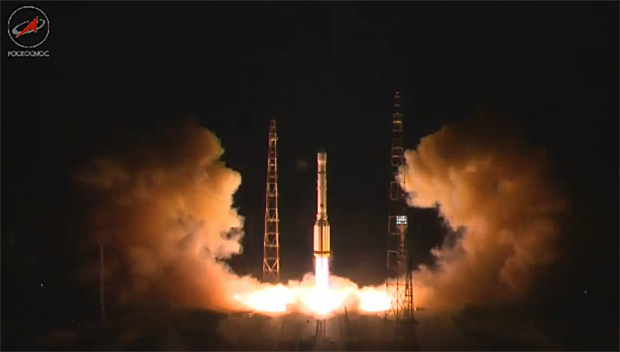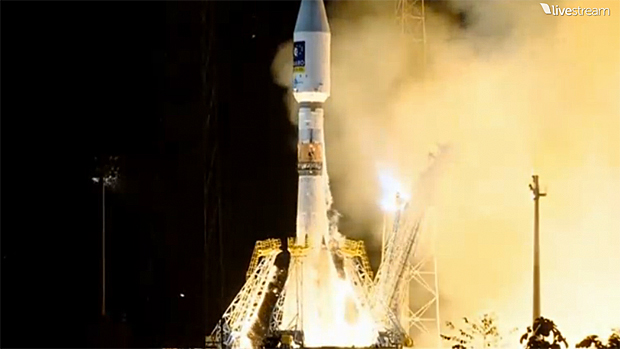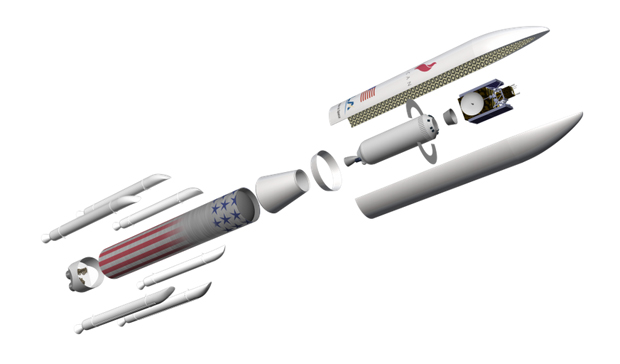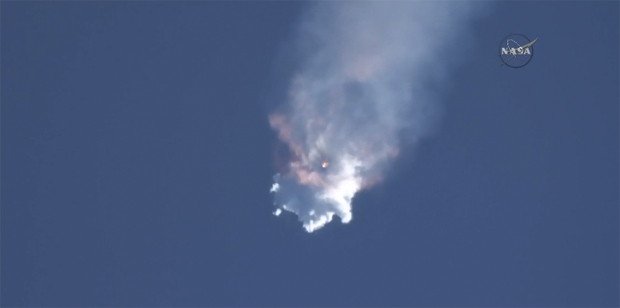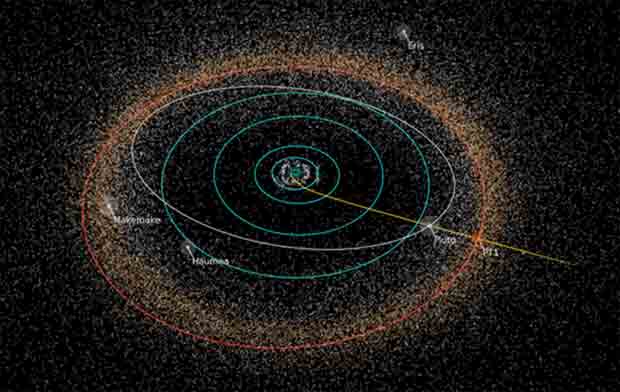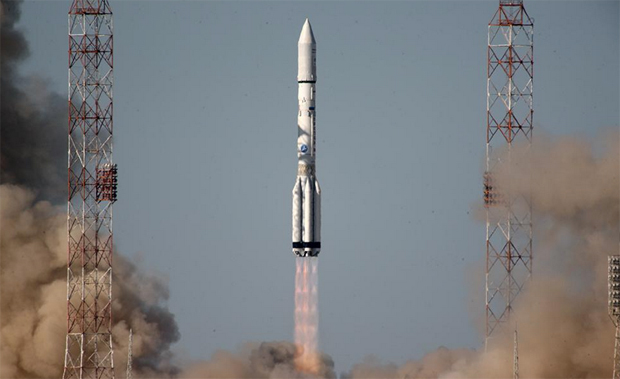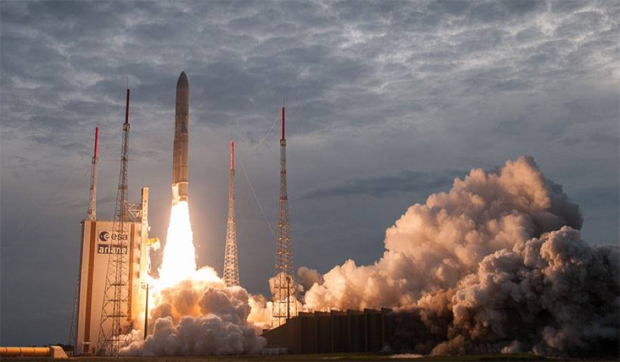CBS News Space Notes
09/10/15: Proton rocket launches Russian communications station
A Russian Proton rocket boosted a powerful Russian communications satellite into orbit Monday after a spectacular overnight launch from the Baikonur Cosmodrome in Kazakhstan.
The towering rocket ignited with a rush of flame at 3 p.m. EDT (1 a.m. Tuesday local time) and quickly climbed away from its firing stand atop a jet of sky-lighting exhaust. A few minutes later, the booster disappeared from view to the east.
Mounted inside a protective nose cone was the Express AM8 relay station, a 4,200-pound communications satellite built for the state-owned Russian Satellite Communications Co., bound for a circular orbit 22,300 miles above the Atlantic Ocean. The spacecraft separated from the Block DM03 upper stage about six-and-a-half hours after launch.
It was the fifth Proton flight this year and the second since an upper stage failure in May.
09/10/15: Soyuz rocket launches two Galileo navsats for Europe
A Russian Soyuz ST-B rocket boosted two European navigation satellites into space Thursday after a picture-perfect launch from the European Space Agency's Kourou, French Guiana, launch site.
The Soyuz lifted off at 10:08 p.m. EDT (GMT-4) and quickly streaked away through the night sky. It was the 12th launch of the Russian booster from French Guiana, the fifth carrying Galileo navigation satellites and the second so far this year.
The two 1,577-pound satellites carried aloft Thursday -- the ninth and tenth in the growing navsat constellation -- were expected to be released at an altitude of about 14,615 miles around 1:46 a.m. Two more Galileo satellites are scheduled for launch in December.
The Galileo system is a European alternative to the Global Positioning System navsats launched by the United States and Russia's Glonass system. The Galileo system is expected to begin service in 2016 with full service using a constellation of 24 satellites and six orbital spares expected by 2020.
09/10/15: Blue Origin, ULA expand production of BE-4 rocket engines
United Launch Alliance, builder of Atlas 5 and Delta 4 rockets, and Blue Origin, builder of the American-made BE-4 engine that will replace Russian RD-180 powerplants in the Atlas booster, have agreed to expand production of the new engine as the companies ramp up to an initial test flight in 2019, officials said Thursday.
Blue Origin, owned by Amazon-founder Jeff Bezos, is developing the BE-4 engine as a high-power alternative to the RD-180, burning liquid oxygen and liquefied natural gas to generate 550,000 pounds of thrust at liftoff. Two BE-4s will power the first stage of ULA's new Vulcan booster, which will replace the venerable Atlas 5.
ULA, a partnership between Delta-builder Boeing and Lockheed Martin, builder of the Atlas family of rockets, announced plans to use the BE-4 to replace the RD-180 last September. The Russian engine, which has a perfect flight record with ULA, has come under intense criticism in the wake of Russia's actions in Crimea and Ukraine, with lawmakers acting to forbid the use of Russian hardware to launch high-priority national security satellites.
Announcing the agreement to expand production of the BE-4, ULA president Tory Bruno said in a statement tthat the partnership "will help the Vulcan rocket exceed the capability of the Atlas 5 on its first flight and open brand new opportunities for the nation's use of space."
Added Bezos: "The BE-4 engine test program is well underway with more than 60 staged-combustion tests already on the books. This new agreement is an important step toward building BE-4s at the production rate needed for the Vulcan launch vehicle."
The agreement comes on the heels of published reports that Aerojet Rocketdyne, builder of a wide variety of rocket engines, including an RD-180 alternative, has offered $2 billion to buy ULA. Neither company has commented on the reports.
09/08/15: Whiskey aged in space comes back with surprisingly different armoa, taste
A maker of single malt Scotch whiskey says small vials containing chemicals responsible for giving whiskey its unique taste, combined with wood shavings from a charred oak bourbon barrel, came back to Earth last year after a 971-day stay aboard the International Space Station with a surprisingly unexpected flavor and aroma.
In a white paper describing the technical aspects of the experiment, Ardbeg, self-proclaimed makers of "the ultimate Islay single malt Scotch whiskey," said the returned samples featured an "intense and rounded" aroma, with "notes of antiseptic smoke, rubber, smoked fish and a curious, perfumed note, like cassis or violet."
"Powerful woody notes, hints of graphite and some vanilla," the white paper continued. "This then leads into very earthy/soil notes, a savory, beefy aroma and then hints of rum and raisin-flavored ice cream."
As for the taste, the company said the spirits aged in space featured a "very focused profile, with smoke fruits ... earthy peat smoke, peppermint, aniseed, cinnamon and smoked bacon or hickory-smoked ham. The aftertaste is pungent, intense and long, with hints of wood, antiseptic lozenges and rubbery smoke."
In nearly every case, the company said, tasters had no trouble distinguishing the station spirits from control samples aged on Earth.
The samples were launched in 2011 and returned to Earth in September 2014 aboard a Russian Soyuz spacecraft. Ardbeg said the research was focused on learning more about the effects of weightlessness on "terpenes," which the company described as "the building blocks of flavor for whiskey spirits as well as many other foods and wines."
09/05/15: After hiatus, New Horizons expected to resume downlink of Pluto flyby pictures
NASA's New Horizons probe, nearly two months past its historic July 14 flyby of Pluto, was expected to resume downlinking stored images of the dwarf planet Saturday after a lengthy period sending back data on energetic particles, the solar wind and space dust.
New, unprocessed imagery will be posted on the spacecraft's Long Range Reconnaissance Imager -- LORRI -- website each Friday, with the next batch of pictures expected Sept. 11.
"The New Horizons mission has required patience for many years," Hal Weaver, the project scientist, said in a news release. "But from the small amount of data we saw around the Pluto flyby, we know the results to come will be well worth the wait."
09/02/15: NASA gives up on SMAP radar instrument
In a major setback for NASA's environmental research program, agency managers have written off the radar instrument aboard the agency's Soil Moisture Active Passive -- SMAP -- satellite due to the sudden failure of a high-power amplifier just three months after science observations began.
Launched Jan. 31, 2015, the $916 million mission was focused on measuring the moisture, frozen and liquid, in the top few inches of Earth's soil to improve forecasting, to better understand the causes and impact of droughts, floods and other natural disasters and to improve long-range climate change projections.
The satellite was equipped with two instruments: an L-band microwave radiometer and the radar system, both sharing a 19.7-foot-wide mesh dish-like reflector. The radar suddenly stopped transmitting July 7 "due to an anomaly involving the radar's high-power amplifier," according to a NASA statement.
"Following an unsuccessful attempt on Aug. 24 to power up the radar unit, the project had exhausted all identified possible options for recovering nominal operation of the HPA and concluded the radar is likely not recoverable," the agency said.
The radiometer, which remains operational, uses microwaves to "see" in daylight and darkness, penetrating clouds, vegetation and the top few inches of soil to measure water volume. The radar provided higher-resolution data complementing the radiometer. Together, the instruments had an effective resolution of 5.6 miles. The radiometer alone has a resolution of about 25 miles.
"Although some of the planned applications of SMAP data will be impacted by the loss of the radar, the SMAP mission will continue to produce valuable science for important Earth system studies," Dara Entekhabi, SMAP Science Team lead at the Massachusetts Institute of Technology, said in NASA's statement.
09/02/15: Engineers troubleshoot cooling problem with Alpha Magnetic Spectrometer
Nature magazine reports that a second cooling pump on in a $2 billion cosmic ray detector aboard the International Space Station is showing signs of trouble. One of the instrument's four cooling pumps failed last year, Nature reported Sept. 2.
The cooling system is needed to offset higher temperatures when the space station, and the AMS instrument attached to a solar array truss, swings into and out of sunlight as the lab orbits Earth. While the AMS detector can operate normally with just one pump, engineers are reviewing telemetry to figure out exactly what might be impacting the pumps' performance to make sure AMS can operate through the remaining life of the space station.
9/01/15: SpaceX Falcon 9 to be grounded longer than expected
SpaceX will need another "couple of months" to recover from the June failure of a Falcon 9 rocket and resume launchings, a company official says.
SpaceX President Gwynne Shotwell told an aerospace conference Monday that engineers are leaving no stone unturned to make sure the next launch is a success. And that goes beyond simply replacing suspect internal struts like the one blamed for the June failure.
"We're taking more time than we originally envisioned to get back to flight, but I don't think any one of our customers wants us to race to the cliff and fail again," she said. "So we're a couple of months away from the next flight, and we will have been through a pretty thorough top-down, single-point failure review.
"Every engineer in the company is having a buddy check their work, and we're doing deep dives throughout our supply chain to make sure we don't see what we saw on our last flight."
Mike Suffredini, NASA's space station program manager at the Johnson Space Center in Houston, said he hopes the company can resume station resupply flights in December, after at least one commercial satellite launching mission using upgraded "full-thrust" Merlin 1D engines.
"I've asked them to be ready to fly up in the December timeframe, which I think is doable for them," Suffredini told CBS News. "We've asked them to put one flight before us on the full-thrust (engines). I think they'd like to fly a couple before us, but that depends on when they get flying again. But their commitment is to try to fly us in the December timeframe."
Meanwhile, SpaceX now plans to launch its first Falcon Heavy rocket in the April-May timeframe, a delay of several months that reflects the company's push to recover from the June failure.
The Falcon Heavy will be the most powerful rocket in the U.S. inventory when it begins flying, capable of lifting more than 115,000 pounds to low-Earth orbit. The rocket will be made up of three Falcon 9 core stages -- with a total of 27 Merlin 1D engines -- bolted together, along with a Merlin-powered second stage.
08/28/15: New Horizons team selects Kuiper Belt flyby target
The New Horizons science team has selected a potential target for a post-Pluto flyby in 2019. The target, 2014 MU69, is one of two candidates discovered by the Hubble Space Telescope that are close enough to the New Horizons trajectory to make a flyby possible.
"Even as the New Horizon's spacecraft speeds away from Pluto ... we are looking outward to the next destination for this intrepid explorer," John Grunsfeld, a former shuttle astronaut who heads up NASA's space science directorate, said in a statement.
"While discussions whether to approve this extended mission will take place in the larger context of the planetary science portfolio, we expect it to be much less expensive than the prime mission while still providing new and exciting science."
While official clearance to proceed with the flyby is not expected until next year, the New Horizons spacecraft will execute four maneuvers in late October and early November to bend the probe's trajectory toward 2014 MU69, also known as "potential target 1," or PT-1.
08/29/15: Russian Proton rocket returns to flight
A powerful Russian Proton rocket making the booster's first flight since a launch failure in May successfully lifted the Inmarsat 5 F3 communications satellite into orbit Friday, releasing the relay station after five upper stage engine firings to put the craft into the proper orbit.
The May failure was blamed on a steering engine in the Breeze M upper stage. Changes were made and the rocket appeared to work normally during the launching Friday.
Spaceflight Now reports that Russia's Express AM8 communications satellite is scheduled for launch on a Proton Sept. 14 with a Turkish relay station scheduled for flight in early October.
08/27/15: NASA concludes initial test firing of upgraded SLS engine
NASA has completed initial test firings of a modified space shuttle main engine that is being upgraded to power the agency's new Space Launch System super booster. The seventh and final "hot fire" in an initial round of testing was carried out Aug. 27 on the A-1 test stand at NASA's Stennis Space Center near Bay St. Louis, Miss.
NASA has 16 space shuttle main engines, now known as RS-25s, that will be used four at a time to power the first stage of the SLS heavy lift booster. The initial test firings collected data to clear the way for slightly higher throttle settings using an upgraded engine controller.
"These are extremely reliable engines," Steve Wofford, SLS engines manager, said in a NASA statement. "We are testing them again because we want to ensure that the engine performs as required with a new engine controller, higher propellant inlet pressures and lower temperatures that are part of the SLS design. We also want to mitigate any risks on the ground before flight."
Running at 109 percent of the thrust originally envisioned for space shuttle engines, the four RS-25's in the SLS first stage will generate about 2 million pounds of thrust at liftoff. Two solid-fuel strap-on boosters will provide an additional 6.4 million pounds of push. The SLS booster is being developed for deep space exploration missions.
08/20/15: Arianespace launches two comsats
A powerful Ariane 5 rocket climbed into space from the European Space Agency's Korou, French Guiana, launch site Aug. 20, boosting a pair of communications satellites into orbit. It was the 67th straight success for the European launcher.
The 12,750-pound Eutelsat 8 West B satellite will provide high-definition direct-to-home television service to Eutelsat customers in the Middle East and North Africa. The second satellite, Intelsat 34, will deliver programming from HBO, Fox and others to Central America and broadband communications for planes and ships in the North Atlantic Ocean.
08/19/15: NASA begins work on hurricane 'microsats'
The Southwest Research Institute near San Antonio, Texas, has started assembly of NASA's Cyclone Global Navigation Satellite System, or CYGNSS, satellites, a suite of eight so-called microsats designed to measure wind speeds near hurricane eyewalls to improve forecasting and weather models.
Managed by the University of Michigan, the CYGNSS spacecraft will fly over the same point on the surface every 12 minutes, using direct and reflected signals from Global Positioning System -- GPS -- navigation satellites to estimate surface wind speeds. Launch aboard an Orbital Sciences Pegasus XL rocket is planned for late 2016.
08/18/15: Send your name to Mars
NASA is inviting space enthusiasts, students, educators and anyone else with an interest in space exploration to send their names to Mars in a microchip that will be launched aboard the agency's InSight lander, which is scheduled for launch in March. The agency will accept names from an InSight web page until Sept. 8.
08/17/15: Cassini makes final close flyby of Saturn's moon Dione
NASA's Cassini Saturn orbiter made its final close flyby of the moon Dione Aug. 17, passing within about 295 miles of the icy, heavily cratered world's surface and beaming back high-resolution pictures and other data.
Earlier flybys, including a pass just 60 miles above the moon in 2011, revealed signs of possible geologic activity, including signs of possible ice volcanoes, "but we've never found the smoking gun," Bonnie Buratti, a Cassini researcher at the Jet Propulsion Laboratory in Pasadena, Calif., said in a NASA release. "The fifth flyby of Dione will be our last chance."
08/13/15: Astronaut Steve Swanson retires from NASA
Astronaut Steve Swanson, veteran of two space shuttle flights and a 169-day stay aboard the International Space Station, is retiring from NASA to become a "distinguished educator in residence" at Boise State University.
Swanson joined the agency in 1987 as a flight engineer at the Johnson Space Center, helping improve navigation and control systems in the shuttle training aircraft astronauts used to simulate shuttle landings. He was selected as an astronaut in 1998. During shuttle missions STS-117 and STS-119, he helped install solar array truss segments during four spacewalks totaling 26 hours.
He performed a fifth spacewalk during a stay aboard the station in 2014 and served as commander of the outpost during Expedition 40.
